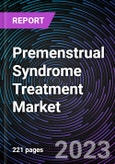This report comes with 10% free customization, enabling you to add data that meets your specific business needs.
Premenstrual Syndrome Treatment Market, By Drug Type
- Analgesics
- Antidepressants
Oral Contraceptives & Ovarian Suppression Agents Premenstrual Syndrome Treatment Market, By Type
- Prescription
- OTC
Premenstrual Syndrome Treatment Market, By Distribution Channel
- Hospital pharmacies
- Drug stores & retail pharmacies
- Online providers
Premenstrual Syndrome Treatment Market by Geography
- North America
- Europe
- Asia Pacific
- Rest of the World
Here is an overview of the key aspects of the PMS treatment market:
On the basis of product type, the market is divided into Analgesics, Antidepressants and Oral Contraceptives & Ovarian Suppression Agents. The modified silicone fluid has the highest share in the market. This is due to the increased adoption of analgesics as first line treatment for the management of PMS.The type segment is bifurcated into prescription and OTC where OTC segment holds the significant share in the market. Since, the most of the consumers prefer OTC medicines to relief pain.
As per the distribution channel, the market is classified into Hospital pharmacies, Drug stores & retail pharmacies and Online providers. The online providers segment is likely to show major growth due to the increase in online purchases.
Medications: Various over-the-counter and prescription medications are available to manage PMS symptoms. Nonsteroidal anti-inflammatory drugs (NSAIDs), such as ibuprofen, can help relieve pain, cramping, and inflammation. Selective serotonin reuptake inhibitors (SSRIs), typically used as antidepressants, may also be prescribed to regulate mood and reduce emotional symptoms associated with PMS.
Hormonal Therapies: Hormonal therapies are sometimes used to address hormonal imbalances which contribute to PMS symptoms. Oral contraceptives, containing a combination of estrogen and progestin, can help regulate hormone levels and alleviate symptoms. Other hormonal treatments, such as gonadotropin-releasing hormone (GnRH) agonists or antagonists, may be considered in severe cases.
Nutritional Supplements: Certain dietary supplements and natural remedies are used to manage PMS symptoms. These may include calcium, magnesium, vitamin B6, and herbal supplements like chasteberry (vitex agnus-castus), evening primrose oil, or black cohosh. However, the scientific evidence supporting the effectiveness of these supplements in relieving PMS symptoms is mixed.
Lifestyle Changes: Lifestyle modifications can play a significant role in managing PMS symptoms. Regular exercise, a balanced diet, stress reduction techniques, and adequate sleep are commonly recommended. Avoiding caffeine, alcohol, and salty foods may also help reduce symptoms such as bloating and breast tenderness.
Psychological Support: Psychological support, such as cognitive-behavioral therapy (CBT) or counseling, can be beneficial for managing emotional symptoms associated with PMS. These therapies help individuals develop coping strategies, improve mood regulation, and address any underlying psychological factors contributing to PMS symptoms.
Market Trends: The PMS treatment market is witnessing a growing demand for personalized and holistic approaches. There is increasing interest in natural and integrative therapies, including herbal remedies and mind-body techniques. Additionally, advancements in technology have facilitated the development of mobile applications and wearable devices that help individuals track their symptoms, identify patterns, and manage their condition more effectively.
It's important to note that the effectiveness of PMS treatments can vary among individuals, and what works for one person may not work for another. It is recommended that individuals consult with healthcare professionals to discuss their symptoms and determine the most appropriate treatment options for their specific need.
The leading players of the market are ABBVIE INC., AstraZeneca plc, BASF Corporation, Bayer AG., Dr. Reddy’s Laboratories Ltd, Eli Lilly And Company., GlaxoSmithKline Plc., H. Lundbeck A/S, Pfizer Inc., Shionogi Inc.
The report analyzes the geographical highlights in terms of consumption of the product/service within the region also indicates the factors which are affecting the market within each
Table of Contents
Companies Mentioned
- AbbVie INC.
- AstraZeneca plc.
- Bayer AG
- BASF Corporation
- Dr. Reddy’s Laboratories Ltd
- Eli Lilly And Company
- GlaxoSmithKline Plc
- H. Lundbeck A/S
- Pfizer Inc
- Shionogi Inc.








